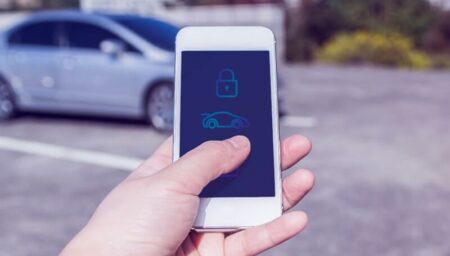Turning smartphones into convenient and flexible car keys

Car keys date back from 1910. At the time, they were used to activate the electric circuit. It would be another 10 years before the ignition key replaces the crank handle. Since then, the car key has evolved to provide both user comfort and anti-theft protection. Improvements in car access security have always been bypassed by thieves sooner or later, and this race does not seem to be over yet, as thieves are using ever more sophisticated techniques.
In the mid-90s, the ignition key was equipped with an encrypted transponder. It provided a second level of anti-theft protection and turned the key, which was initially mechanical, into a communicative object. In the early 2000s, the key became able to open the vehicle remotely via radio transmission of a code to a receiver in the car. Nowadays, more and more cars are equipped with hands-free keys, which you only need to have in your pocket to automatically open the vehicle doors a few meters away (keyless system). As the radio signal is encrypted, it was reasonable to believe that we had taken a significant step towards the perfect anti-theft device. But thieves have not stopped looking for a way to get around this problem. Some studies show most cars are still vulnerable to thieves.
In 2017, a joint study by the Swiss Touring Club and the ADAC1 concluded that the 100 cars tested, equipped with a keyless system, could “be opened in a few seconds using a homemade radio amplifier without forced entry2.”
Nowadays, these hands-free car keys have become more widely available and offer a high level of user comfort. However, as their radio signal still does not provide a sufficient level of anti-theft security, car manufacturers are exploring other solutions. The future lies in using smartphones and contactless cards (NFC technology, i.e. Near Field Communication, also used for bank cards), ensuring both ease of use and security. This feature, introduced within high-end vehicles of several carmakers, will gradually become more widely available.
Smartphones have become the central object of people’s daily lives. Rare are those who forget them, even for short errands. Therefore, it makes sense for smartphone manufacturers and carmakers to work together to gradually replace car keys.
Smartphones will be at the center of the progress towards hands-free car access and ignition. Thanks to their communication abilities, Bluetooth, NFC, integration of UWB (Ultra Wide Band for precise location) technology, and their capability to secure exchanges, smartphones appear to be the easiest and safest solution.
“Smartphone keys” enable new use cases such as user key management or multiple-user profiles for a shared vehicle, whether within a family or in the context of mobility as a service (car sharing, short-term rentals, use instead of ownership, etc.). This is a solution used by shared mobility operators. You no longer need to go and pick up a key or badge at a service provider desk. Everything is done remotely via an application.
These digital car keys are highly secure. They cannot be duplicated since they are unique to each user and connect wirelessly to the car through integrated sensors. They can also be secured by exchanging authentication certificates over the network. In case of theft or loss, the key function or the smartphone itself can be remotely deactivated.
Some car manufacturers are providing an NFC card in addition to this digital hands-free key, in the same size as a credit card. These NFC cards provide a backup solution in the event of an incident, battery failure or if you forget your smartphone. This type of card can also be a valuable branding tool for carmakers and customers, depending on how “premium” its level of finish may be.
There is no doubt that these digital car keys and NFC cards that can easily be slipped into your wallet, will gradually replace the keys for cars of the future for greater convenience and security.
1 Allgemeiner Deutscher Automobil-Club: https://www.adac.de/
2 https://www.tcs.ch/mam/Digital-Media/PDF/Booklets/Vol-de-voitures-avec-syst-me-sans-cl.pdf
